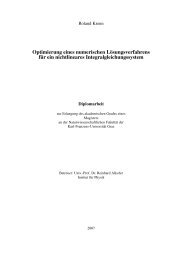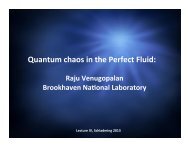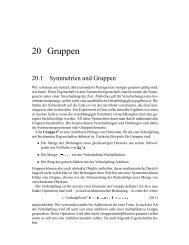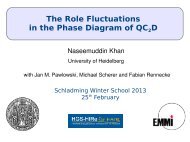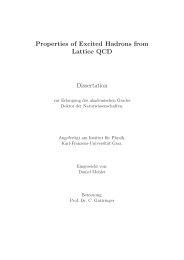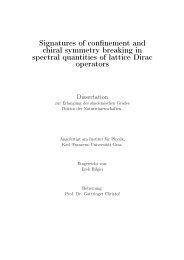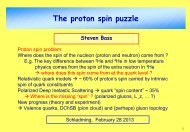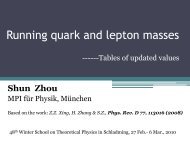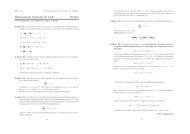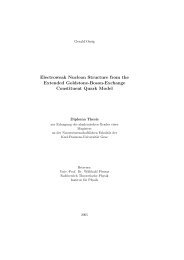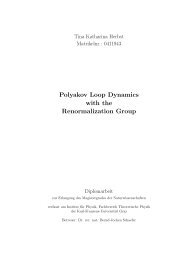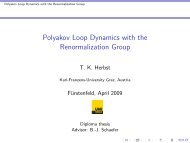The QCD Quark Propagator in Coulomb Gauge and - Institut für Physik
The QCD Quark Propagator in Coulomb Gauge and - Institut für Physik
The QCD Quark Propagator in Coulomb Gauge and - Institut für Physik
Create successful ePaper yourself
Turn your PDF publications into a flip-book with our unique Google optimized e-Paper software.
Chapter 1<br />
Prologue<br />
Quantum Chromo Dynamics (<strong>QCD</strong>) is the SU(3) gauge theory of quarks <strong>and</strong> gluons <strong>and</strong><br />
nowadays the widely accepted theory of strong <strong>in</strong>teraction. Together with the Glashow-<br />
Salam-We<strong>in</strong>berg Model of electroweak <strong>in</strong>teractions, which succeeded <strong>in</strong> provid<strong>in</strong>g a unified<br />
description of the electromagnetic <strong>and</strong> weak <strong>in</strong>teractions, <strong>QCD</strong> builds the so-called St<strong>and</strong>ard<br />
Model of elementary particle physics. For high momenta, which correspond to small<br />
distances, the quarks behave like free particles, a phenomenon which is known as asymptotic<br />
freedom. In this momentum regime perturbative calculations have been carried out<br />
which agree well with the performed experiments. At low <strong>and</strong> <strong>in</strong>termediate momenta up<br />
to several GeV however the <strong>QCD</strong> coupl<strong>in</strong>g constant is too large <strong>in</strong> order to apply perturbation<br />
theory. This is physically required s<strong>in</strong>ce neither quarks nor gluons have been detected<br />
as free particles so far. <strong>The</strong>refore the conf<strong>in</strong>ement hypothesis was established: Only s<strong>in</strong>glets<br />
of the gauge group occur as physical particles, which implies that both quarks <strong>and</strong><br />
gluons should never appear <strong>in</strong>dividually. Yet this statement still awaits a rigorous proof.<br />
Together with conf<strong>in</strong>ement chiral symmetry break<strong>in</strong>g is the outst<strong>and</strong><strong>in</strong>g fundamental low<br />
energy property of <strong>QCD</strong>. Hadron phenomenology, especially the low energy relations <strong>in</strong><br />
pion physics, the sum rules derived from current algebra <strong>and</strong> the relations among meson<br />
masses left no doubt about the spontaneous break<strong>in</strong>g of chiral symmetry. S<strong>in</strong>ce neither<br />
quarks nor gluons can have nonvanish<strong>in</strong>g vacuum expectation values, the break<strong>in</strong>g of chiral<br />
symmetry has to take place dynamically.<br />
Our underst<strong>and</strong><strong>in</strong>g of how observable properties of hadrons emerge from the underly<strong>in</strong>g<br />
structure of the strong <strong>in</strong>teraction is still far from complete. Nevertheless <strong>in</strong> the last<br />
years considerable progress has been achieved amongst others <strong>in</strong> lattice calculations. For<br />
example <strong>in</strong> [D + 04] an unquenched parameterfree calculation for a restricted set of observables<br />
test<strong>in</strong>g several aspects of lattice <strong>QCD</strong> was reported. With u <strong>and</strong> d quark masses<br />
only about three times larger than the realistic value the agreement with experiment was<br />
1



